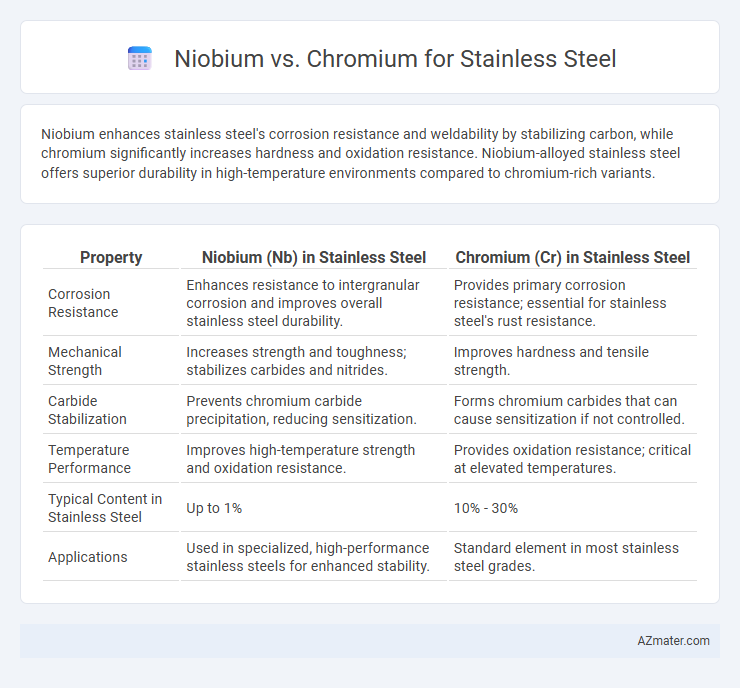Niobium enhances stainless steel's corrosion resistance and weldability by stabilizing carbon, while chromium significantly increases hardness and oxidation resistance. Niobium-alloyed stainless steel offers superior durability in high-temperature environments compared to chromium-rich variants.
Table of Comparison
| Property | Niobium (Nb) in Stainless Steel | Chromium (Cr) in Stainless Steel |
|---|---|---|
| Corrosion Resistance | Enhances resistance to intergranular corrosion and improves overall stainless steel durability. | Provides primary corrosion resistance; essential for stainless steel's rust resistance. |
| Mechanical Strength | Increases strength and toughness; stabilizes carbides and nitrides. | Improves hardness and tensile strength. |
| Carbide Stabilization | Prevents chromium carbide precipitation, reducing sensitization. | Forms chromium carbides that can cause sensitization if not controlled. |
| Temperature Performance | Improves high-temperature strength and oxidation resistance. | Provides oxidation resistance; critical at elevated temperatures. |
| Typical Content in Stainless Steel | Up to 1% | 10% - 30% |
| Applications | Used in specialized, high-performance stainless steels for enhanced stability. | Standard element in most stainless steel grades. |
Introduction to Niobium and Chromium in Stainless Steel
Niobium and chromium are critical alloying elements in stainless steel, each enhancing corrosion resistance and mechanical properties. Chromium forms a stable oxide layer that protects steel from rust and oxidation, making it essential for stainless steel's durability. Niobium improves grain structure and prevents carbide precipitation, enhancing strength and preventing intergranular corrosion, particularly in stabilized stainless steel grades.
Chemical Properties and Roles in Alloy Formation
Niobium enhances stainless steel alloy formation by improving corrosion resistance through stable carbide formation and grain refinement, maintaining strength at high temperatures. Chromium provides essential oxidation resistance and forms a passive oxide layer that protects stainless steel from corrosion and rust. The chemical stability of niobium carbides versus chromium carbides significantly influences the alloy's durability and weldability, making niobium crucial for stabilizing grades susceptible to intergranular attack.
Impact on Corrosion Resistance
Niobium enhances the corrosion resistance of stainless steel by stabilizing carbon and preventing chromium carbide precipitation, which minimizes intergranular corrosion. Chromium provides the primary corrosion resistance through the formation of a passive oxide layer on the steel surface, essential for protecting against rust and various chemical attacks. Combining niobium with chromium in stainless steel ensures improved durability in harsh environments by maintaining chromium levels and enhancing overall resistance to corrosion mechanisms.
Effect on Mechanical Strength and Hardness
Niobium enhances stainless steel's mechanical strength and hardness primarily through grain refinement and precipitation strengthening, forming niobium carbides that inhibit grain growth and improve toughness. Chromium contributes to hardness by forming a stable and protective oxide layer, yet its direct impact on mechanical strength is less pronounced compared to niobium. The addition of niobium typically results in higher tensile strength and improved hardness, making it a crucial alloying element for high-performance stainless steels.
Influence on Weldability and Fabrication
Niobium enhances stainless steel weldability by stabilizing carbon and preventing carbide precipitation, which reduces intergranular corrosion and improves joint strength during high-temperature welding. Chromium contributes to corrosion resistance but can form chromium carbides at grain boundaries, leading to weld decay and reduced toughness in welded areas. Niobium's influence on fabrication results in better dimensional stability and less sensitization compared to chromium-rich stainless steels, optimizing performance in demanding welded structures.
Cost and Availability Comparison
Niobium's cost is generally higher than chromium due to its limited global reserves and specialized extraction processes, impacting stainless steel production budgets. Chromium, more abundant and widely mined, provides a cost-effective solution, contributing to stainless steel's corrosion resistance and hardness at a lower price point. Availability of chromium ensures stable supply chains, whereas niobium's scarcity can cause price volatility and potential delays in manufacturing.
Environmental and Health Considerations
Niobium enhances stainless steel by improving corrosion resistance and reducing chromium content, minimizing the environmental impact associated with mining and processing chromium. Chromium, while essential for stainless steel's corrosion resistance, poses higher health risks due to potential carcinogenic hexavalent chromium compounds formed during welding or corrosion. Using niobium-enriched alloys contributes to safer workplace conditions and lowers ecological toxicity compared to chromium-intensive stainless steel production.
Industrial Applications and Use Cases
Niobium significantly enhances stainless steel's strength and corrosion resistance, making it ideal for demanding industrial applications such as chemical processing, aerospace, and marine environments. Chromium improves stainless steel by providing excellent oxidation resistance and surface hardness, widely used in kitchen equipment, automotive parts, and construction materials. In high-temperature and highly corrosive settings, niobium-stabilized stainless steel outperforms chromium-rich alloys due to its superior creep strength and resistance to intergranular corrosion.
Performance in Extreme Environments
Niobium enhances stainless steel's resistance to high-temperature corrosion and improves mechanical strength in extreme environments, making it ideal for aerospace and chemical processing applications. Chromium provides excellent oxidation and corrosion resistance by forming a stable passive layer, crucial for durability in harsh, oxidizing atmospheres. Combining niobium with chromium in stainless steel alloys significantly boosts thermal stability and structural integrity under severe thermal cycling and corrosive conditions.
Choosing the Right Element for Stainless Steel Alloys
Niobium enhances stainless steel alloys by improving corrosion resistance and stabilizing against carbide precipitation, which boosts weldability and prevents intergranular corrosion. Chromium significantly increases hardness, wear resistance, and forms a passive oxide layer that protects stainless steel from rust and oxidation. Selecting between niobium and chromium depends on the desired balance of mechanical strength, corrosion resistance, and specific application requirements in stainless steel production.

Infographic: Niobium vs Chromium for Stainless Steel
 azmater.com
azmater.com